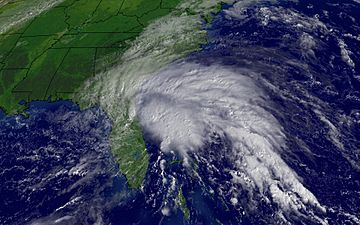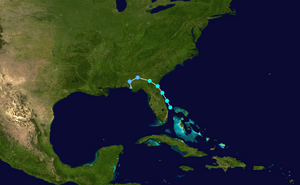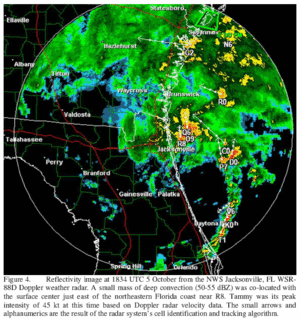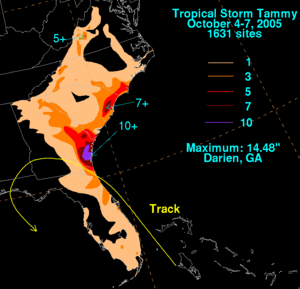Tropical Storm Tammy (2005) facts for kids
| Tropical storm (SSHWS/NWS) | |

Tropical Storm Tammy off the coast of Florida.
|
|
| Formed | October 5, 2005 |
|---|---|
| Dissipated | October 6, 2005 |
| Highest winds | 1-minute sustained: 50 mph (85 km/h) |
| Lowest pressure | 1001 mbar (hPa); 29.56 inHg |
| Damage | $30 million (2005 USD) (Paid losses from FEMA only) |
| Areas affected | Bahamas, Florida, Georgia |
| Part of the 2005 Atlantic hurricane season | |
Tropical Storm Tammy was the nineteenth named storm of the 2005 Atlantic hurricane season. This storm only lasted for two days. It caused some minor damage in the southeastern United States.
Tammy reached its strongest point with winds of 50 mph (85 km/h). This happened just before it hit the northern Florida coast. Most of the damage costs were paid by FEMA. These costs added up to about $30 million.
Tammy started as a strong weather system on October 5. It formed near the Florida coast. It moved north and reached its peak strength. Tammy then made landfall near Atlantic Beach, Florida on October 6. The storm quickly lost its power after that. What was left of Tammy was later absorbed by a cold front in the Gulf of Mexico.
Contents
How Tropical Storm Tammy Formed
A tropical wave is like a ripple in the air. One of these waves left the coast of Africa on September 24. It traveled across the Atlantic without getting stronger.
But by October 2, the wave started to get more organized. This happened while it was north of the Lesser Antilles. It kept getting stronger as it moved through the Bahamas. By October 5, it became a well-organized tropical disturbance near eastern Florida.
Since the system already had strong winds, it was immediately named Tropical Storm Tammy. It skipped the stage of being a tropical depression. Weather experts at the National Hurricane Center thought Tammy might travel north. They were not sure exactly where it would hit land.
Tropical Storm Tammy got a little stronger. It reached its peak with 50 mph (85 km/h) winds. It then made landfall near Atlantic Beach, Florida on the same day. Tammy moved inland over Georgia. It quickly weakened to a tropical depression. By October 6, it had lost all its strength.
The weak remains of Tammy slowly moved south towards the Gulf of Mexico. A cold front then absorbed it. This cold front also picked up another weak storm. The combined system affected much of the northeastern United States. Weather experts watched to see if Tammy would get stronger over the Gulf of Mexico. But strong winds high up in the atmosphere stopped it from reforming.
Getting Ready for Tammy
A tropical storm warning was issued very quickly. This warning covered the coast from Cocoa Beach, Florida to the Santee River, South Carolina. It was put out as soon as Tropical Storm Tammy formed on October 5.
Tammy moved inland at the southern part of the warning area. It then moved north towards Altamaha Sound, Georgia. All warnings were stopped on October 6.
Tammy's Impact and Damage
Tropical Storm Tammy caused only minor damage. The biggest problem with Tammy was flooding. The strongest steady winds recorded were 50 mph. These were reported a few miles northeast of the storm's center. The strongest wind gust was near 60 mph.
Many areas in northeast Florida and southern Georgia had steady winds over 40 mph. This was because Tammy had a very wide area of strong winds. Most places received 3 to 5 inches of rain. Some isolated spots got as much as 10 inches of rain.
In Georgia, several homes were damaged by flooding. Also, some roads were washed out. Two pond dams broke in Georgia. The storm surge from Tammy was about 2 to 4 feet high. Many boardwalks were washed away. There was also some beach erosion in Florida, Georgia, and South Carolina.
Besides the flooding, a small F0 tornado was reported. This tornado caused some damage to roofs and broke trees in Brunswick, Georgia. The total damage from Tammy was about $30 million in 2005. About 16,500 people in southeast Georgia lost power during the storm.
The leftover parts of Tammy were absorbed by a larger weather system. This system moved north. Tammy's moisture helped create another storm over the northeastern U.S. This later storm caused some damage and led to ten deaths.
Tammy's Name and Records
When Tropical Storm Tammy formed on October 5, it set a new record. It was the earliest in the season that the twentieth storm had formed. It broke the old record from 1933 by 21 days.
Tammy was only the second Atlantic storm ever to be named with the letter 'T'. The first was Tanya in 1995. This was also the first time the name Tammy had been used for any tropical storm anywhere in the world.
Because Tammy caused only minor damage, its name was not removed from the list. The World Meteorological Organization decided to keep it. The name Tammy was used again for the 2011 hurricane season.
Related Pages




